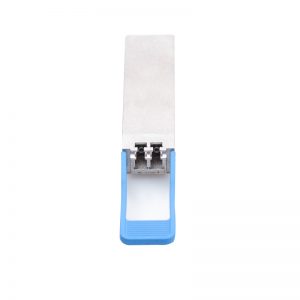100G QSFP28 Transceiver Overview and How to Choose It
Overview
As the unprecedented network growth of data center, high-performance computing networks, enterprise core and distribution layers, and service provider application etc., a cost effected, high-density and low-power 100G Ethernet connectivity solution is in need urgently. Based on this, the 100G QSFP28(Quad Small Form-Factor Pluggable) transceiver is exactly what you need as a preferred network solution. The major features below are the most of advantages by utilizing 100G QSFP28 transceiver:
Features
- Techniques supported by all network devices manufacturers
- Hot-pluggable to 100G Ethernet QSFP28 port
- Compliant with 100G EthernetIEEE 802.3bm
- Compliantto SFF-8665(QSFP28 Solution) Revision 1.8
- Supports 100G data rate links of up to 30km
- Low power consumption of max 4.5w
- Smallest size
Table 1. 100G QSFP28 Transceiver Portfolio
100G QSFP28 SR4 Transceiver
This full-duplex module offers 4 independent transmit and receive channels, reach to 70 meters by OM3 MMF(multi mode fiber) and 100 meters by OM4 MMF. The four channels of signal come thru the paralleled module via the MPO/MTP connector to complete the progress of transmission. QSFP28 transceiver as a entry level for 100G Ethernet solution, it’s a priority for short reach links such as data interchange centre or service centre.

Table 2. 100G QSFP28 Port Cabling Specs
100G QSFP28 LR4 Transceiver
The 100G QSFP28 Transceiver is the module designed for transmission span of up to 10km operated over SMF(single mode fiber) via LC connector. When start to run the module to connect with the data links, it will be converting each individual channel of electrical signal to LAN WDM optical signal and then multiplex all 4 channels of 25G signal into a output of 100G single channel, this is undergoing on the transmit side. While on the receive side that’s a reverse procedure via the demultiplex’s reaction i.e. 100G input of optical signal be demultiplexed to LAN WDM signal and then converted to 4 channels of 25G electrical signal.
LC and MPO/MTP Connector
LC Connector is very common for optical module application particularly for QSFP28 transceiver, which is a SFF(small form factor) connector developed by Lucent. The 1.25mm ferrule is precisely designed for high density cabling. In according to the diverse attributes it has been sorted into SMF(single mode fiber) LC & MMF LC connector and duplex and simplex LC connector.

Figure 1. LC Connector Interface
MPO/MTP Connector involves 12 to 24 combined fibers within the single rectangular ferrule, it’s ubiquitously used for 100G Optical parallel module of MMF. This connector is much more complicated than others and categorised by key-up & key-down, and male & female MPO/MTP connector.
Figure 2. MPO/MTP Connector Interface
100G QSFP28 IR4 PSM Transceiver
Look into the definition of 100G PSM4 MSA(multi source agreement), 100G QSFP28 PSM4 transceiver is operating over 4 paralleled lanes(4 transmit and 4 receive) on each direction. At this point it’s same as 100G QSFP28 SR4 transceiver. But differently, it requires eight single mode fibers to coordinate the PSM4’s deployment in transmission links. The reach of up to 2km stay at a medium level between SR and LR modules, which makes it complemental to the 100G QSFP28 transceiver family, diversity of choice and much more economic.
100G QSFP28 CWDM4 Transceiver
By applying CWDM technology the 100G QSFP28 CWDM4 successfully integrates and multiplexes four differed wavelength(1270nm, 1290nm, 1310nm and 1330nm) into one SMF for signal transmission, similar to the process of 100G QSFP28 LR4 on the receive side. The incoming signal is demultiplexed to separated four channels over another SMF, therefore you can see the total usage of SMF is two rather than eight compare to 100G QSFP28 IR4 PSM transceiver. The reach of 100G QSFP28 CWDM4 Transceiver is up to 2km.
CWDM(Coarse Wavelength Division Multiplex) Vs DWDM(Dense Wavelength Division Multiplex)
Both CWDM and DWDM technology are in purpose for broadening bandwidth, maximizing usage of fiber and ultimately optimize the network. They can send various data flow simultaneously over a single mode fiber. CWDM is a flexible deployment for fiber networks especially for point to point topology of enterprise networks while DWDM is considered to connect the metropolitan network, interconnecting data center and financial service network. Following is a table display to summarise the main differences between CWDM and DWDM.

Table 3. Comparison of CWDM and DWDM

Table 3. Comparison of CWDM and DWDM
100G QSFP28 ER4 Lite Transceiver
What if customers have demand to build a ultra-long link 100G network beyond 10km 100G QSFP28 LR4 transceiver? The answer is absolute! The 100G QSFP28 ER4 Lite transceiver is exactly born to meet your demand of this specialty. It adopts EML laser in transmit side and multiplexes/demultiplexes four lanes signal come from four wavelength(1295.56nm, 1300.05nm, 1304.58nm and 1309.14nm) which is operating over one single mode but dual fibers. Particularly there is TEC(thermo electric cooler) inside the construction to steady inner temperature and prevent wavelength from flowing. The enhanced reach of 100G QSFP28 ER4 Lite is 30km or above.
Table 4. Optical Characteristics
Comparable To Third-Party QSFP28
All 10Gtek’s 100G QSFP28 Transceiver is friendly compatible with third-party QSFP28 device, such as Cisso, Extreme, Brocade, Juniper, HP, Dell, Arista, Huawei and other known brands. Our 100G QSFP28 transceiver will give you a excellent solution to establish network connection without expensive. For further technical details you are suggested to download the documentations by refer to our official webs: www.sfpcables.com or www.10gtek.com
Conclusion
Table 5. Ordering Information
Based on above profile for 100G QSFP28 transceiver, do you have any idea to choose the module for what you need? If you have any questions, you are so much welcomed to contact us directly by E-mail info@10gtek.com or phone. Besides, 10Gtek’s online shop is on hot sales right now, you may also browse our shop (www.sfpcables.com) and ask for help online.




